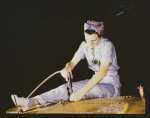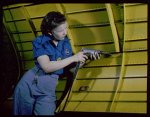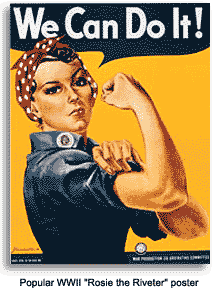 |
|||
|
|||
|
Part
5 of 5 |
|||
| "All
the day long whether rain or shine |
|||
|
|
|||
| The 1940s proved to be a difficult time for lesbians in publishing. War in Europe had begun brewing in the previous decade, and by 1941, the United States was embroiled in it. Gay and lesbian elders from that time have consistently confided in me that many of them thought this might just be the end of the world, and because of that, many women - and even more men - tossed aside social strictures regarding homosexuality, and (as one 82-year-old gay relative recently put it), "we let it all hang out." |
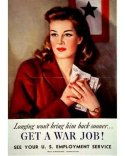 |
||
|
|
|||
|
|
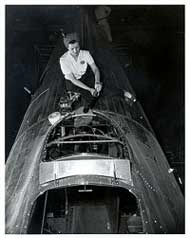
|
||
|
|
|||
Somewhere between six and seven million women toiled to build planes, bombs, tanks, weapons, and machinery that eventually helped to win WWII. Many thousands more also joined the military as members of the Army WACs, Navy WAVES, Air Force WASP, or Army Nurse Corps, or worked in civilian administrative or nursing positions. In an environment where people thought the world might come to an end, strong bonds - sometimes of true love - were forged between women laboring alongside one another both in the factories at home in the States and also all over the globe wherever they were stationed as support workers. Pressed into service from every hamlet, town, and city, is it any surprise that lesbians found each other? |
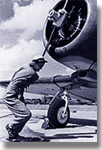 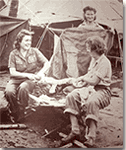
|
||
 |
|||
| Prior to WWII, women were encouraged to marry, stay at home, and raise children. Amazingly, America's entry into the war seemed like overnight, the dominant cultural message changed as the government, the press, and people in communities all across the nation encouraged women to step up and do the work of absent male soldiers. The first mention of a new cultural heroine, Rosie the Riveter, was in the 1942 song of the same name written by Redd Evans and John Jacob Loeb. The song was hugely popular and was soon followed by a Saturday Evening Post cover (right) painted by Norman Rockwell, which was also entitled "Rosie the Riveter." Women in the factories by then were all referred to as Rosies, and the most famous poster of all, paid for by the Westinghouse Corporation and published in winter 1944, was the picture below. Sixty years later, you can still get this poster. Women still wear t-shirts, use coffee mugs, and adorn their walls with the simple image of a strong-looking female flexing her muscles. |
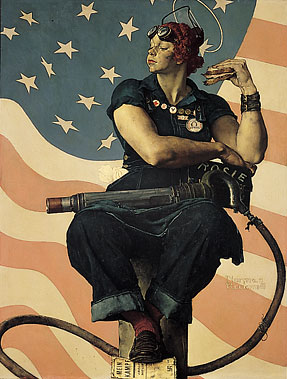 Rosie the Riveter, a painting by Norman Rockwell, 1943 |
||
|
Popular Knock-off of the Rosie |
I know that the myth of Rosie the Riveter doesn't fit neatly into this category of the Herstory of Lesbian Novels, but the symbol is so strong, so compelling, that I can't ignore it. The changes of the 1940s let the cat out of the bag, so to speak. Women who had never before worked outside the home went out into the world and earned a living wage. Women who had never traveled went where the U.S. military sent them. Women who had been sheltered and who expected to be some man's wife suddenly found themselves working with drills and welding equipment, assembling mechanical parts, and sometimes supervising crews of workers. Many of them found themselves working with all classes and colors of women - and men, too. | ||
Even after the war years ended and a glut of men returned and took away the higher-paid industrial jobs, women continued to be an integral part of the workforce. Perhaps the nation assumed that women's foray into industrial work was temporary, but many of the Rosies did not. They'd gotten a taste of independence and physical labor and wanted to use their smarts and skills. Some of them even began to write! |
|||
| Resources Here are three great books about the Rosies and the women of WWII:
CLICK HERE if you'd like to read the words to the song, "Rosie the Riveter." CLICK HERE if you'd like to hear the original (2:22 minutes) by the Four Vagabonds on Bluebird Records, complete with ukulele, horns, and 4-part harmony - also some cool pix of the women working on air force bombers while wearing overalls - and dresses, too! CLICK HERE if you'd like to hear some testimonials and discussion by some real Rosie the Riveters, and CLICK HERE to find out about "The Last Rosie" - 2014. Lastly, there's
a Rosie
the Riveter World War II Home Front National Historical Park.
Located in Richmond, California, it contains a Rosie the Riveter Memorial
honoring women's labor during the war. When it was dedicated on October
14, 2000, two hundred real-life Rosies, all of whom were in their
late 70s and early 80s, attended the dedication ceremony. |
|||
 |
|||
| If
you are curious to learn about a particular topic or have information
to share, please write to me at: Lori (at) LoriLLake (dot) com Thanks for reading this five part series! I look forward to someone else doing the SECOND half of the Twentieth Century! Lori |
|||
| |
|||
 | |||
| This page last updated on July 2, 2022 Go to other parts of the Lesbian Herstory Series: Part
1 Or Return to Lori L. Lake's Main Website All contents of this web site are protected by U.S.
and International copyright laws | |||
 Lesbian
Fiction Herstory
Lesbian
Fiction Herstory